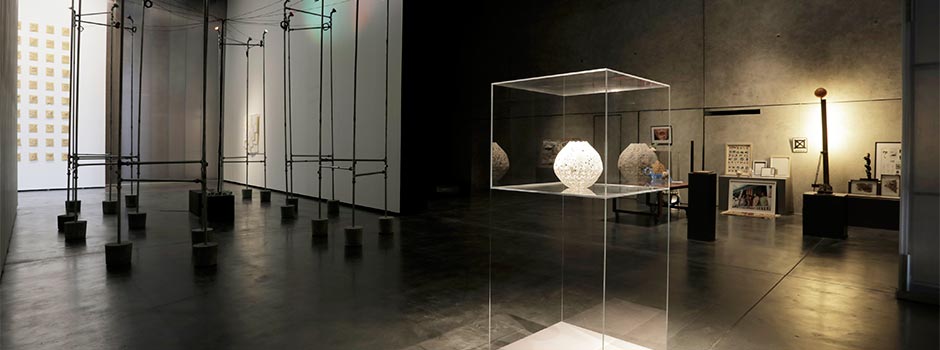
EXHIBITION Ishara: Signs, Symbols & Shared Languages opens in Concrete in Alserkal Avenue
Mar 04, 2018 Exhibition

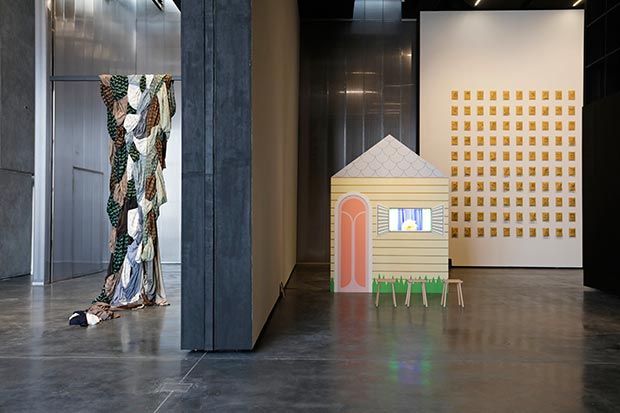 Exhibition view of Ishara - Signs, Symbols and Shared Languages in Concrete / Image credit Musthafa Aboobacker / Courtesy of UAE Unlimited and Alserkal Programming
Exhibition view of Ishara - Signs, Symbols and Shared Languages in Concrete / Image credit Musthafa Aboobacker / Courtesy of UAE Unlimited and Alserkal Programming
Ishara: Signs, Symbols and Shared Languages, UAE Unlimited’s fourth annual exhibition opened in Concrete, Alserkal Avenue. Commissioned by UAE Unlimited, in collaboration with Alserkal Programming, and supported by the Ministry of Culture and Knowledge Development, the exhibition will run until 1 April 2018.
The exhibition opened in the presence of H.H. Sheikh Zayed bin Sultan bin Khalifa Al Nahyan, Founder and patron of UAE Unlimited, H.E. Noura Al Kaabi, Minister of Culture and Knowledge Development, Mohammad Al-Murr, Chairman of the Board of Trustees of the Arabic Language Award and Abdelmonem Bin Eisa Alserkal, Founder of Alserkal Avenue, Alserkal Programming and Concrete. Ishara is curated by Karim Sultan and features new works by 10 UAE-based artists as well as a work by guest artists Ramin Haerizadeh, Rokni Haerizadeh and Hesam Rahmanian that they describe as ‘visual poetry’.
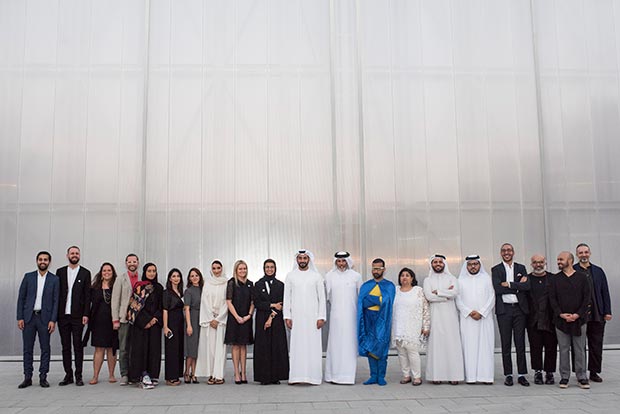 Group photo with dignitaries and all participating artists, Ishara exhibition in Concrete / Image credit Abbi Kemp / Courtesy of Alserkal Programming and UAE Unlimited
Group photo with dignitaries and all participating artists, Ishara exhibition in Concrete / Image credit Abbi Kemp / Courtesy of Alserkal Programming and UAE Unlimited
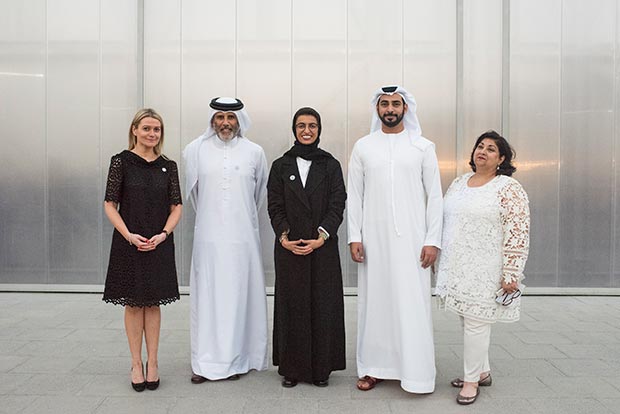 Vilma Jurkute, Abdelmonem Bin Eisa Alserkal, HE Noura Al Kaabi, HH Sheikh Zayed bin Sultan bin Khalifa Al Nahyan, Shobha Pia Shamdsani, Ishara exhibition in Concrete / Image credit Abbi Kemp /Ccourtesy of Alserkal Programming and UAE Unlimited
Vilma Jurkute, Abdelmonem Bin Eisa Alserkal, HE Noura Al Kaabi, HH Sheikh Zayed bin Sultan bin Khalifa Al Nahyan, Shobha Pia Shamdsani, Ishara exhibition in Concrete / Image credit Abbi Kemp /Ccourtesy of Alserkal Programming and UAE Unlimited
“As our exhibitions have developed over the years, so too, have the size and scale of the artworks. With this year's edition, our commissioned artists were given the opportunity to produce artworks that would be on display in this spectacular space, Concrete; to experiment with proportions found only in leading global museums,†says H.H. Sheikh Zayed bin Sultan bin Khalifa Al Nahyan.
“We are proud to have Concrete—a space re-imagined for the purpose of showcasing world-class talent—be part of UAE Unlimited’s journey through the Emirates. Art and culture have an immeasurable impact on our sense of identity and purpose and joining hands to further the cause of arts and culture helps us widen our reach,†added Abdelmonem Bin Eisa Alserkal.
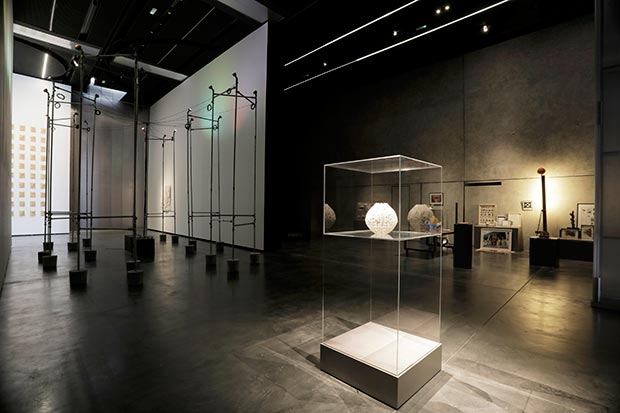 Ishara exhibition view, March 2018 / Image credit Musthafa Aboobacker / Courtesy UAE Unlimited and Alserkal Programming
Ishara exhibition view, March 2018 / Image credit Musthafa Aboobacker / Courtesy UAE Unlimited and Alserkal Programming
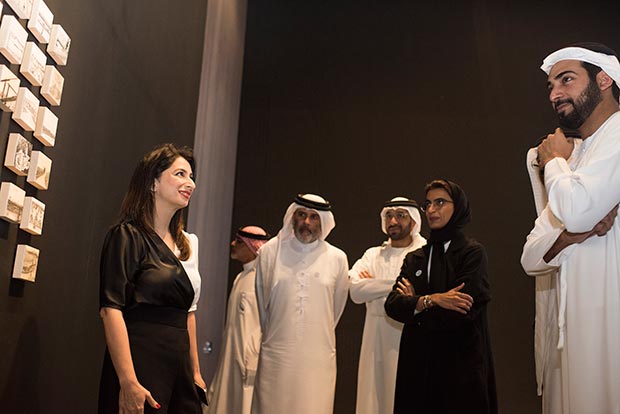 Saba Qizilbash, Abdelmonem Bin Eisa Alserkal, HE Noura Al Kaabi and HH Sheikh Zayed bin Sultan bin Khalifa Al Nahyan, Ishara exhibition in Concrete / Image credit Abbi Kemp / Courtesy of Alserkal Programming and UAE Unlimited
Saba Qizilbash, Abdelmonem Bin Eisa Alserkal, HE Noura Al Kaabi and HH Sheikh Zayed bin Sultan bin Khalifa Al Nahyan, Ishara exhibition in Concrete / Image credit Abbi Kemp / Courtesy of Alserkal Programming and UAE Unlimited
The ten artists—Amna Al Dabbagh, Cheb Moha, Chndy, Dina Khorchid, Farah Al Qasimi, Flounder Lee, Nasir Nasrallah, Saba Qizilbash, Salem Al Mansoori, and Shaikha Al Ketbi—created works for the exhibition that were thematically informed by the idea of lingua franca, and the understanding of the meaning and use of language. In Arabic, Ishara, denotes ‘sign’—the most basic form of communication, and refers to the linguistic marks, gestures and indications, as well as commonly used signals that transcend language, like those used in traffic or urban spaces. The artists have responded to the theme through a diverse set of practices and approaches, from drawing and print-making to immersive video works and responsive installations.
Dubai-based guest artists, Ramin Haerizadeh, Rokni Haerizadeh, and Hesam Rahmanian played an important role in mentoring the commissioned artists and providing guidance to help grow their practices. This format of mentorship has been central to UAE Unlimited’s exhibitions since its inception in 2015. Ramin Haerizadeh, Rokni Haerizadeh, and Hesam Rahmanian have created a work for the exhibition, which they describe as visual poetry, based on the environment they created in their studio during reading groups, which brought the artists together for weekly discussions. For each session they curated the setting, choosing collected objects based on humble materials and discourses, that resonated with the themes in the readings as well as questions that were being asked by the artists as they presented their processes.
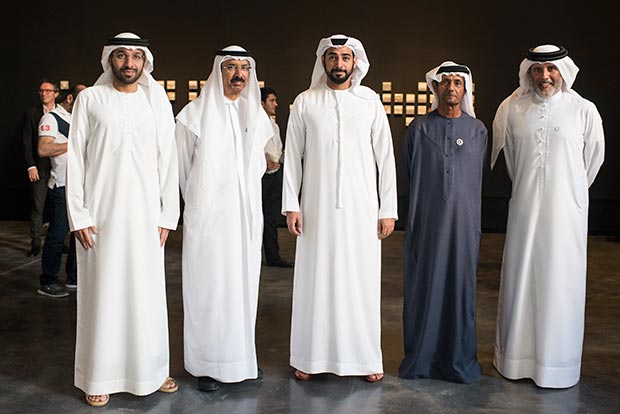 Saeed Al Naboodah, Mohammad Al Murr, HH Sheikh Zayed bin Sultan bin Khalifa Al Nahyan, Mr Al Qasimi, Abdelmonem Bin Eisa Alserkal, Ishara exhibition in Concrete / Image credit Abbi Kemp / Courtesy Alserkal Programming and UAE Unlimited
Saeed Al Naboodah, Mohammad Al Murr, HH Sheikh Zayed bin Sultan bin Khalifa Al Nahyan, Mr Al Qasimi, Abdelmonem Bin Eisa Alserkal, Ishara exhibition in Concrete / Image credit Abbi Kemp / Courtesy Alserkal Programming and UAE Unlimited
“Books were selected that matched or countered the discussions, objects were gathered that intervened as well. They all became amalgamations that evolved and responded. We saw it all as visual poetry in the midst of discussion. Rather than being an exercise, the setting wasn’t discussed directly, it became a catalyst for conversations at some point or otherwise a silent observer, often interested in complicating the notions of language at the core of the exhibition,†say the guest artists.
Ishara: Signs, Symbols and Shared Languages is curated by Karim Sultan, with Laura Metzler as Senior Adviser. The exhibition has been designed by Waqas Khan. Essays by UAE-based writers Saira Ansari and Taibah Albisher were included in the catalogue; this is the first time that UAE Unlimited has commissioned essays around the exhibition’s theme.
The works that are part of the exhibition are:
Salem Al Mansoori: Going Inside, 2018, In The Dictionary, 2018 and Body Language, 2018. In this project three seminal texts and a speech by Sheikh Zayed are used to control the profess of generative design. The texts were all read aloud and the quantifiable data of the recordings were fed through an algorithm to produce a physical interpretation of the contents.
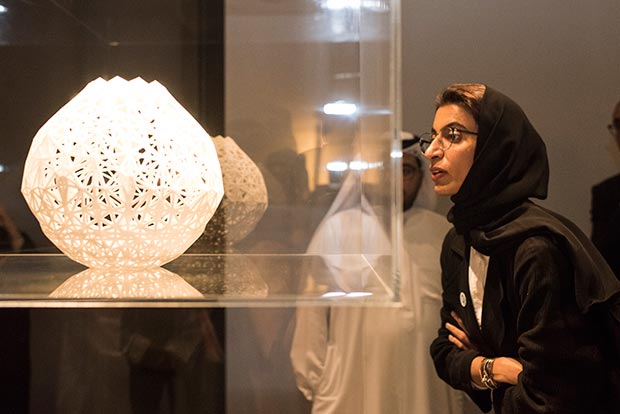 HE Noura Al Kaabi views work by Salem Al Mansoori, Ishara exhibition in Concrete / Image credit Abbi Kemp / Courtesy of Alserkal Programming and UAE Unlimited
HE Noura Al Kaabi views work by Salem Al Mansoori, Ishara exhibition in Concrete / Image credit Abbi Kemp / Courtesy of Alserkal Programming and UAE Unlimited
Amna Al Dabbagh: The Hanging Odes, 2018 is an interpretive poetry installation of the Al Mu’allaqat Being mostly concealed due to the form of the installation, the words of the poems are read in a different way that creates new meaning.
Dina Khorchid: In Through a Trail, 2018 prints and hanging scrolls add, subtract, hide and reveal information that is layered as though waiting to be unfolded, like tales of a present past, carried and transported in a non-linear language that travels through boundaries, intersections and times.
Farah Al Qasimi: Everybody was Invited to a Party, 2018 pulls inspiration from the 1980s Arabic version of Sesame Street (Iftah Ya Simsim), using puppets to present language and letters as malleable objects without fixed meaning. The video seeks moments where failure to communicate creates a new opportunity.
Flounder Lee: Mycelial Meshing, 2018. Using the materials of infrastructure—steel pipes, concrete, electrical cables—Mycelial Meshing looks at the varied networks of communication through the overlay of mycelial networks. Overall the work reacts to the audience, seemingly communicating about the visitor’s intrusion.
Nasir Nasrallah: Forgotten Title, 2018 encases 100 everyday objects in envelopes with a coded description written on the surface. The code does not have a key and will be forgotten completely over time, left undecipherable.
Saba Qizilbash: Land Marks, 2018 responds to the physical transitional spaces of borders allowing the artist to immerse herself in the inquiry of these imagined and inviolable boundaries where constant separation and surveillance take place.
Shaikha Al Ketbi: Ath’thaniyah, 2018 is an exploration of the artist’s subconscious, retrieving and constructing a monument accessed through her dreams. The work is process based, almost role playing the dream, and leads to more subconscious reactions, giving birth to more monuments.
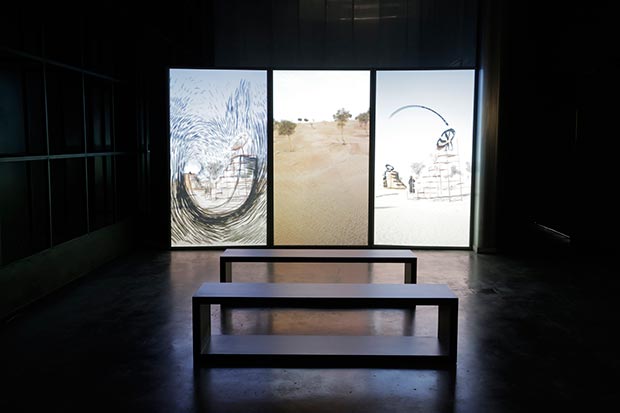 Shaikha Al Ketbi Ath'thaniyah video installation, part of Ishara exhibition / Image credit Musthafa Aboobacker / Courtesy of UAE Unlimited and Alserkal Programming
Shaikha Al Ketbi Ath'thaniyah video installation, part of Ishara exhibition / Image credit Musthafa Aboobacker / Courtesy of UAE Unlimited and Alserkal Programming
This year Ishara is also including two projects by local creatives who are experimenting digitally. Chndy and Cheb Moha will each be developing projects on Instagram accounts that deal with the themes of language and communication. Viewers can access them on screens and iPads in the exhibition but also on their own devices and follow throughout the exhibition.
Comments
Add a comment